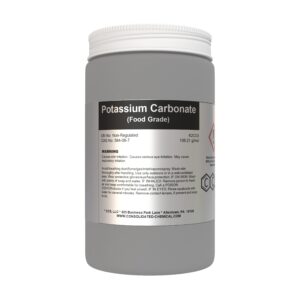Benzoic Acid – High-Purity Industrial and Food-Grade Preservative
$12.00 – $36.00
Chemical Identity:
- Chemical Name: Benzoic Acid
- CAS Number: 65-85-0
- Molecular Formula: C7H6O2
- Molecular Weight: 122.12 g/mol
- Synonyms: Carboxybenzene, Phenylformic Acid
Physical Properties:
- Appearance: White crystalline powder or flakes
- Odor: Slightly aromatic
- Density: ~1.32 g/cm³
- Melting Point: 122°C (252°F)
- Boiling Point: 249°C (480°F)
- Flash Point: 121°C (250°F) (closed cup)
- Solubility:
- Slightly soluble in water (~0.34 g/100 mL at 25°C)
- Freely soluble in ethanol, acetone, and other organic solvents
SKU: N/A
Categories: Preservative, Uncategorized
Tags: Antimicrobial Benzoic Acid, Benzoic Acid, Benzoic Acid antimicrobial properties, Benzoic Acid bulk supplier, Benzoic Acid flakes, Benzoic Acid for beverages, Benzoic Acid for chemical synthesis, Benzoic Acid for corrosion inhibition, Benzoic Acid for cosmetics, Benzoic Acid for dyes and resins, Benzoic Acid for food preservation, Benzoic Acid for industrial applications, Benzoic Acid for lab use, Benzoic Acid for organic synthesis, Benzoic Acid for personal care products, Benzoic Acid for pH adjustment, Benzoic Acid for pharmaceuticals, Benzoic Acid for pickles, Benzoic Acid for research use, Benzoic Acid for soft drinks, Benzoic Acid powder, Benzoic Acid preservative, CAS 65-85-0, Food-grade Benzoic Acid, High-purity Benzoic Acid, Industrial-grade Benzoic Acid, Organic Benzoic Acid, Pharmaceutical-grade Benzoic Acid, Preservative-grade Benzoic Acid, White crystalline Benzoic Acid
Description
Benzoic Acid is a highly effective preservative used across various industries. Known for its antimicrobial properties, it is widely employed in food and beverage preservation, cosmetic formulations, and industrial processes. Its ability to inhibit microbial growth makes it essential for maintaining product quality and extending shelf life.
This high-purity Benzoic Acid is available in food-grade and industrial-grade options, ensuring suitability for a wide range of applications.
Applications of Benzoic Acid
- Food and Beverage Industry:
- Preservative: Commonly used to inhibit the growth of mold, yeast, and bacteria in foods like jams, jellies, pickles, and sauces.
- Beverages: Found in carbonated drinks, fruit juices, and syrups to maintain freshness.
- Processed Foods: Extends the shelf life of baked goods, dairy products, and condiments.
- Cosmetic and Personal Care Industry:
- Preservative: Used in lotions, creams, shampoos, and other personal care products to prevent microbial growth.
- pH Adjuster: Helps stabilize the pH of formulations for improved product stability.
- Pharmaceutical Industry:
- Excipient: Used as a preservative in topical creams, ointments, and liquid medications.
- Active Ingredient: Found in some antifungal and antibacterial formulations.
- Tablet Manufacturing: Acts as a stabilizer in oral solid dosage forms.
- Industrial Applications:
- Chemical Intermediate: Used in the production of dyes, plastics, and synthetic resins.
- Corrosion Inhibitor: Added to industrial fluids and solutions to prevent metal corrosion.
- pH Adjuster: Controls acidity in industrial processes and formulations.
- Agriculture:
- Animal Feed: Preserves feed quality by preventing microbial contamination.
- Crop Protection: Utilized in some pesticide formulations for stability.
- Research and Laboratory Use:
- Organic Synthesis: Key reagent in laboratory experiments and chemical research.
- Standard Solution Preparation: Used in titration and calibration processes.
- Textile and Paper Industry:
- Bleaching and Dyeing: Acts as an auxiliary agent in textile processing.
- Preservative: Prevents microbial growth in paper products during storage.
- Environmental Applications:
- Wastewater Treatment: Used in controlling microbial growth in water systems.
- pH Control: Adjusts acidity levels in environmental remediation processes.
Storage:
- Store in a cool, dry, and well-ventilated area (15°C–25°C).
- Keep in tightly sealed, corrosion-resistant containers.
- Avoid moisture, direct sunlight, and contact with oxidizers, acids, or bases.
Handling:
- Wear gloves, goggles, and a dust mask.
- Handle in a ventilated space to minimize inhalation of dust.
- Avoid direct contact with skin and eyes. Wash hands after handling.
Disposal:
- Dispose of according to local hazardous waste regulations. Use licensed services for bulk disposal.
Safety Notes:
- May cause mild irritation upon prolonged exposure.
- Keep away from heat, sparks, and open flames.
- Refer to the SDS for detailed safety instructions.
Additional information
| Size | 100 GRAMS, 250 GRAMS, 500 GRAMS, 1000 GRAMS |
|---|
Related products
-

Dihydroterpineol (Menthanol) Aroma/Flavor Compound High Purity
$12.00 – $32.00 Select options This product has multiple variants. The options may be chosen on the product page -

Triethyl Citrate HP Aroma/Flavor/Fragrance Compound
$12.00 – $150.00 Select options This product has multiple variants. The options may be chosen on the product page -

Beta-Caryophyllene (Food Grade) – High Purity Aroma Compound
$9.99 – $52.00 Select options This product has multiple variants. The options may be chosen on the product page -

Potassium Carbonate – Food Grade (E501)
$24.99 – $39.99 Select options This product has multiple variants. The options may be chosen on the product page







